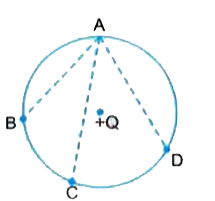A positively charged ball hangs from a long silk thread. Electric field at a certain point (at the same horizontal level of ball) due to the ball is E. If now put a postive test charge q0 at this point and measure Fq0, then E
When we try to measure the electric field at point P then after placing the test
Charge at P it repels the source charge (suspended charge) and the measured value of electric field Emeasured=Fq0 will be less than the actual value Eact that we wanted to measure.

Topper's Solved these Questions
- ELECTROSTATICSBOOK - MOTIONCHAPTER - ELECTROSTATICSEXERCISE - SELF MISCELLANEOUS PROBLEM (Example )
15 Videos
- ELECTROSTATICSBOOK - MOTIONCHAPTER - ELECTROSTATICSEXERCISE - SELF PRACTICE PROBLEM
27 Videos
- ELECTRONICS - SEMI CONDUCTORBOOK - MOTIONCHAPTER - ELECTRONICS - SEMI CONDUCTOREXERCISE - EXERCISE - 3
29 Videos
- ELECTROSTATICS - I BOOK - MOTIONCHAPTER - ELECTROSTATICS - I EXERCISE - EXERCISE - 4 (Level -II) PREVIOUS YEAR - JEE ADVANCED
13 Videos
Similar Questions
A point charge q produces an electric field of magnitude 2.0NC−1 at a point distant 50 cm from it. From the value of q.
View SolutionA small positively charged ball of mass m is suspended by an insulating thread of length L. This ball remains in equilibrium with string horizontal when another small charged ball is placed exactly at a distance L below the point of suspension of the first ball. The second ball is slowly moved away from the first ball to a far away point. (The second ball is moved horizontally so that the first ball does not accelerate). As a result the first ball lowers down to the original position of the second ball and the string become vertical. Find the work done by the external agent in removing the second ball.

View Solution
Knowledge Check
A positively charged ball hangs from a long silk thread. Electric filed at a certain point (at the same horizontal level of ball) due to this charge is E. Let us put a positive test charge q0 at this point and measure F/q0 on this charges. then E
A>F/q0B<F/q0C=F/q0Dnone of theseA hollow metal ball carrying an electric charge produces no electric field at points
Aoutside the sphereBon its surfaceCinside the sphereDonly at the centreA charged ball B hangs from a silk thread S, which makes an angle θ with a large charged conducting sheet P, as shown in figure. The surface charge density σ of the sheet is proportional to
 A(a) cotθB(b) cosθC(c) tanθD(d) sinθ
A(a) cotθB(b) cosθC(c) tanθD(d) sinθ
A point charge q is placed at the origin . How does the electric field due to the charge very with distance r from the origin ?
View SolutionA charged ball B hangs from a silk thread S, which makes an angle θ with a large charged conducting sheet P, as shown in the figure. The surface charge density σ of the sheet is proportional to

View SolutionIn the electric field of a point charge Q placed at the centre of a circle, as shown in fingure, a certain test charge q0 is carried from point A to B, C B and D. Then the work done

View SolutionA point charge q produces an electric field of magnitude 2NC−1 at a point distance 0.25 m from it. What is the value of charge ?
View SolutionInside a hollow conducting sphere, which is uncharged, a charge q is placed at its center. Let electric field at a distance x from center at point p be E and potential at this point be V. Now, some positive charge Q is given to this sphere, then

View Solution
